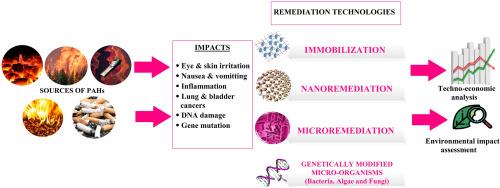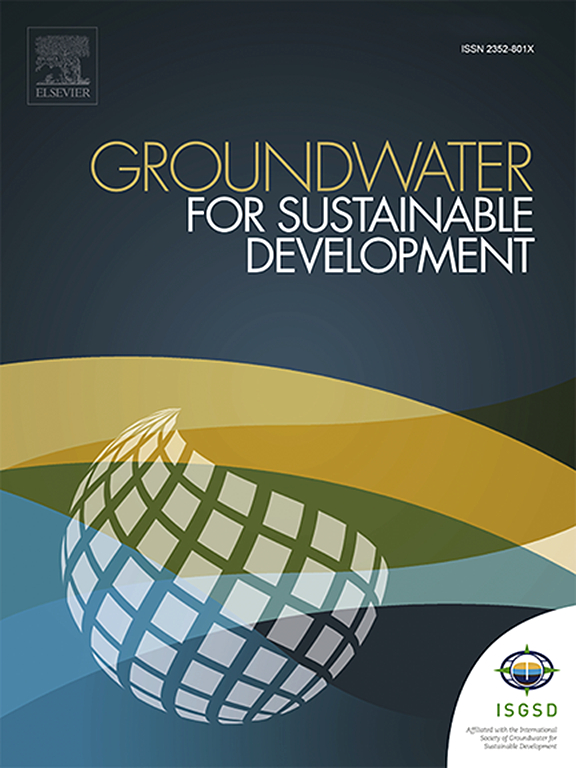多环芳烃污染场地强化微生物生物修复战略的关键分析:毒性和技术经济分析
IF 4.9
Q2 ENGINEERING, ENVIRONMENTAL
引用次数: 0
摘要
多环芳烃(PAHs)具有高毒性、持久性和生物累积潜力,对环境完整性和公众健康构成重大威胁。在受污染的土壤中,多环芳烃的浓度通常在 1 到 100 毫克/千克之间,严重污染地区可达 1000 毫克/千克。传统的生物修复技术效率仅限于 30%-50%,因此需要更有效的解决方案。本综述重点介绍了微生物生物修复策略的最新进展,通过利用功能微生物将多环芳烃代谢为无毒化合物,其去除效率高达 80-90%。基因工程、微生物固定化和纳米技术等创新技术可实现 90% 以上的污染物去除率。综述讨论了驱动多环芳烃降解的关键代谢途径和酶过程,如环羟化和氧合。技术经济评估表明,与传统方法相比,该方法可节省高达 40% 的成本并提高能源效率,从而有利于大规模环境修复项目的可扩展性。多环芳烃的含量通常超过 0.2 微克/升的最高污染水平 (MCL),针对地下水污染的微生物解决方案在降低生态风险和保护公众健康方面非常有效。这项全面的分析凸显了先进的微生物生物修复技术在解决土壤、沉积物和水生环境等不同生态系统中多环芳烃污染问题方面的巨大作用。本文章由计算机程序翻译,如有差异,请以英文原文为准。

Critical analysis of enhanced microbial bioremediation strategies of PAHs contaminated sites: Toxicity and techno-economic analysis
Polycyclic aromatic hydrocarbons (PAHs) pose significant threats to environmental integrity and public health due to their high toxicity, persistence, and potential for bioaccumulation. In contaminated soils, PAH concentrations typically range from 1 to 100 mg/kg, with severely polluted areas reaching up to 1000 mg/kg. Conventional bioremediation techniques, limited to 30–50% efficiency, underscore the need for more effective solutions. This review highlights recent advancements in microbial bioremediation strategies, demonstrating removal efficiencies of 80–90% through the utilization of functional microorganisms, which metabolize PAHs into non-toxic compounds. Innovative techniques such as genetic engineering, microbial immobilization, and nanotechnology are shown to achieve over 90% pollutant removal. The review discusses key metabolic pathways and enzymatic processes driving PAH degradation, such as ring-hydroxylation and oxygenation. Techno-economic assessments indicate up to 40% cost savings and improved energy efficiency compared to conventional methods, facilitating scalability for large-scale environmental restoration projects. Microbial solutions for groundwater pollution, where PAH levels often exceed the maximum contaminant level (MCL) of 0.2 μg/L, are found to be highly effective in mitigating ecological risks and protecting public health. This comprehensive analysis highlights the promising role of advanced microbial bioremediation techniques in addressing PAH contamination across diverse ecosystems, including soils, sediments, and aquatic environments.
求助全文
通过发布文献求助,成功后即可免费获取论文全文。
去求助
来源期刊

Groundwater for Sustainable Development
Social Sciences-Geography, Planning and Development
CiteScore
11.50
自引率
10.20%
发文量
152
期刊介绍:
Groundwater for Sustainable Development is directed to different stakeholders and professionals, including government and non-governmental organizations, international funding agencies, universities, public water institutions, public health and other public/private sector professionals, and other relevant institutions. It is aimed at professionals, academics and students in the fields of disciplines such as: groundwater and its connection to surface hydrology and environment, soil sciences, engineering, ecology, microbiology, atmospheric sciences, analytical chemistry, hydro-engineering, water technology, environmental ethics, economics, public health, policy, as well as social sciences, legal disciplines, or any other area connected with water issues. The objectives of this journal are to facilitate: • The improvement of effective and sustainable management of water resources across the globe. • The improvement of human access to groundwater resources in adequate quantity and good quality. • The meeting of the increasing demand for drinking and irrigation water needed for food security to contribute to a social and economically sound human development. • The creation of a global inter- and multidisciplinary platform and forum to improve our understanding of groundwater resources and to advocate their effective and sustainable management and protection against contamination. • Interdisciplinary information exchange and to stimulate scientific research in the fields of groundwater related sciences and social and health sciences required to achieve the United Nations Millennium Development Goals for sustainable development.
 求助内容:
求助内容: 应助结果提醒方式:
应助结果提醒方式:


